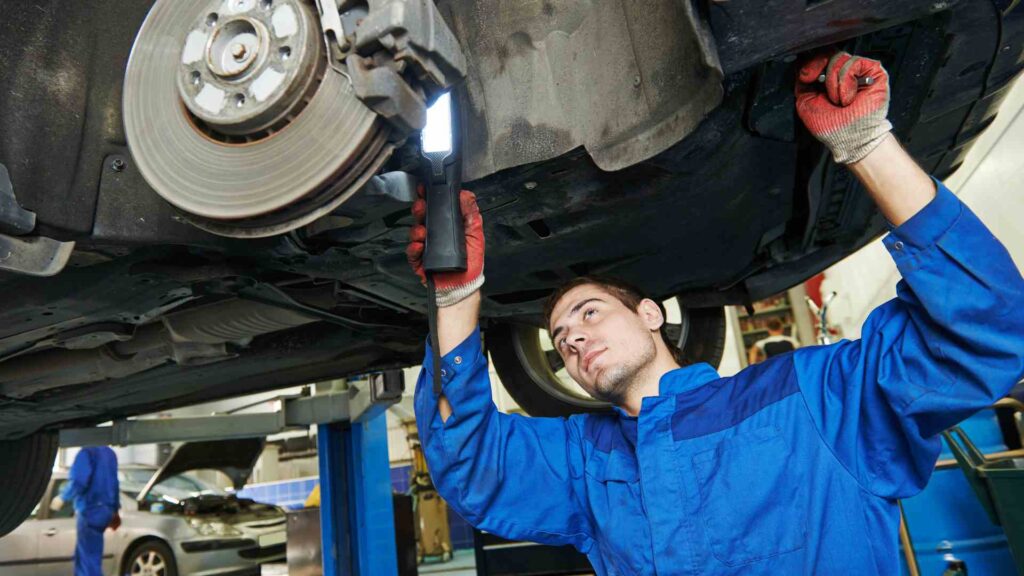Step-by-Step Guide to Extending Your Car’s Brake Life | YST Auto Service
Maximize your car’s brake longevity in the Greater Toronto Area! YST Auto Service‘s expert guide covers brake maintenance, repair, inspection, and tips to save money and enhance safety.
Step-by-Step Guide for Extending the Lifespan of Your Car’s Brakes
Your vehicle’s braking system is unquestionably one of its most important safety features. The ability to slow down and stop effectively is not just for your safety but also for your passengers and other road users in the bustling Greater Toronto Area (GTA). However, brakes are wear-and-tear components, meaning they deteriorate over time with use. The good news is that with a combination of smart driving habits, regular brake maintenance, and timely brake inspection and brake service, you can significantly extend your brake longevity, saving you money on unnecessary brake replacement and potentially costly brake repair.
At YST Auto Service, we understand the unique challenges GTA drivers face—from stop-and-go traffic on the highways to navigating city streets and dealing with harsh Canadian winters. This comprehensive guide is intended to provide you with the knowledge necessary to maximize the life of your brakes. Our goal is to help you maintain optimal braking performance, ensure your safety, and keep your vehicle running smoothly for years to come.
Keep in mind that your car is a major investment, so consider taking your car to YST Auto Service for a full car inspection. YST Auto Service is your one-stop destination auto repair garage in Mississauga, Toronto. Our professional mechanics can identify potential issues and ensure your vehicle is ready for the changing season.
YST Auto Service is an excellent choice for professional car maintenance. Our dedication to quality, convenience, and customer satisfaction makes us an outstanding choice for drivers looking for regular car servicing. With a team of qualified technicians, a wide range of services, and an emphasis on fair pricing and sustainable techniques, YST Auto Service is well-equipped to handle your car maintenance needs promptly and professionally.
At YST Auto Service, we deliver only the highest quality car services and repairs. We provide all manner of auto repair and car maintenance services to keep your vehicle running strong and smooth. From keeping proper tire traction to ensuring your battery is up to the task, these tips will help you enjoy the autumn drive with confidence and comfort.
Step-by-Step Guide for Extending the Lifespan of Your Car’s Brakes
The Impact of Driving Habits on Brake Longevity
Your unique driving style is one of the most important, yet often underestimated, factors determining brake lifespan While brake components are designed to withstand considerable stress, the way you drive directly influences how quickly they wear out.
Aggressive driving, such as quick acceleration followed by harsh, last-minute stopping, puts great stress on your brake pads, rotors, and callipers. This style forces the braking system to work much harder, generating excessive heat. Heat is the primary enemy of brake components; it can cause brake fluid to degrade, brake pads to wear down rapidly (a process known as glazing if severe), and even lead to warped rotors. If you frequently find yourself slamming on the brakes in busy Toronto traffic or on highways, you are significantly shortening the lifespan of your brakes and increasing the likelihood of needing brake repair or brake replacement.
In contrast, taking a smoother, more conservative driving strategy will significantly lengthen the life of your brakes. This involves anticipating traffic flow, maintaining a safe following distance, and applying the brakes gently and progressively. By looking further down the road, you can often identify situations requiring you to slow down much earlier, allowing you to ease off the accelerator and let engine braking assist in deceleration before you even touch the brake pedal. This “coasting” technique reduces the reliance on your friction brakes, thereby minimizing wear. For example, if you see a red light or stop traffic ahead, instead of maintaining speed until the last moment, lift your foot off the gas and allow the car to slow naturally. Then, apply the brakes smoothly to come to a complete stop. This simple change can contribute significantly to brake maintenance by reducing the frequency and intensity of brake applications.
Another factor to consider is avoiding speeding. Following too closely not only increases the risk of a collision but also forces you to react more sharply to the vehicle in front, often leading to sudden, hard braking. Maintaining a generous following distance, especially in the unpredictable conditions of GTA commuting, gives you more time and space to react, allowing for gentler braking and promoting brake longevity.
Furthermore, consider the weight your vehicle is carrying. An overloaded car requires more force to stop, putting additional stress on the braking system. Regularly removing unnecessary heavy items from your trunk or cabin can make a small but cumulative difference. For those driving manual transmission vehicles, proficient use of engine braking by downshifting appropriately can also take some load off the service brakes, particularly on downhill gradients. Even in automatic vehicles, many now come with paddle shifters or a manual mode that allows for some degree of engine braking, which can be beneficial if used correctly.
Also, consider the impact of road conditions. Potholes and uneven surfaces, unfortunately common in some areas, can jar the entire vehicle, including the braking system components. While not directly causing brake wear, repeated shocks can affect alignment and suspension, indirectly impacting braking stability and potentially leading to uneven wear if not addressed. To maximize the life of your brakes, use a balanced approach to driving that takes into account both your actions and your surroundings.
Lastly, for hybrid and electric vehicle owners in the GTA, leveraging regenerative braking is a game-changer for brake longevity. These systems capture kinetic energy during deceleration and convert it back into electrical energy to charge the battery, significantly reducing the wear on traditional friction brakes. Mastering the art of one-pedal driving or maximizing regenerative braking settings can mean your brake pads last exceptionally long, often exceeding 150,000 kilometers or more.
However, even with regenerative braking, regular brake inspection is still important to ensure the mechanical components are in good order and that the brake fluid is maintained, as it can still absorb moisture over time regardless of pad wear. YST Auto Service is equipped to handle the specific brake service needs of all vehicle types, including hybrids and EVs, ensuring your advanced braking systems are performing optimally.
Understanding these nuances of driving can transform you from a passive user into an active participant in your vehicle’s brake maintenance routine, ultimately pushing back the need for frequent brake service or costly brake replacement. Remember that every gentle stop is a step towards longer-lasting brakes and a safer journey. Investing a little thought into how you drive can yield substantial savings and peace of mind.

How to Avoid Costly Brake Repairs?
Preventative or proactive brake maintenance is arguably the most effective strategy for maximizing brake longevity and ensuring your vehicle remains safe on the busy roads of the Greater Toronto Area. Instead of waiting for a problem to develop, such as a squealing noise, a soft pedal, or a warning light, regular inspection of your braking system can identify and address minor issues before they escalate into more significant and costly brake repair scenarios, or worse, compromise your ability to stop effectively.
A comprehensive brake maintenance schedule should be a part of your overall vehicle care plan, particularly given the stop-and-go nature of GTA traffic and the harsh seasonal changes that can impact brake components.
What does proactive brake maintenance include?
Regular Visual Inspections
Even without specialized tools, you can perform basic visual checks. Look at your brake rotors through the wheel spokes—are they smooth and shiny, or do they show deep grooves or scoring? While harder to see without removing the wheel, try to gauge the thickness of your brake pads.
Many modern vehicles also have wear indicators on the pads that will emit a high-pitched squeal when the pads are nearing the end of their life – this is an auditory cue for an imminent brake inspection. Check your brake fluid reservoir (usually a translucent plastic container in the engine bay). The fluid level should be between the “min” and “max” lines. If it’s low, it could indicate worn pads (as fluid fills the calliper pistons’ increased travel) or a potential leak. The fluid itself should be relatively clear; dark or murky fluid suggests contamination and the need for a fluid flush.
Professional Brake Inspection
A professional brake checkup should be performed at regular intervals, typically annually or as recommended by your vehicle manufacturer (often around every 20,000 to 30,000 kilometers, but this can vary widely).
During a professional brake inspection, technicians will:
- Measure brake pad thickness accurately.
- Measure brake rotor thickness and check for runout (warping) and parallelism.
- Inspect callipers for proper operation, leaks, and seized slider pins or pistons.
- Examine brake lines and hoses for cracks, bulges, rust, or leaks.
- Check the condition and level of the brake fluid, often testing for moisture content.
- Inspect wheel bearings and seals, as these can affect braking stability.
- Check the parking brake for proper adjustment and operation.
This comprehensive brake service provides a detailed snapshot of your braking system’s health.
Brake Fluid Service
As mentioned, brake fluid is hygroscopic and degrades over time. Most manufacturers recommend a brake fluid flush and replacement every two to three years, regardless of mileage. Contaminated brake fluid can lead to a spongy pedal, reduced braking efficiency (brake fade), and internal corrosion of expensive components like the ABS modulator or callipers. This is a critical aspect of brake maintenance that directly impacts safety and brake longevity of the hydraulic components. Ignoring it can lead to more complex brake repair down the line.
Cleaning and Lubrication
Especially important in the GTA due to road salt in winter and general road grime, brake components can benefit from periodic cleaning and lubrication of moving parts (like calliper slide pins). Salt and debris can cause corrosion and seizing, leading to uneven wear and premature brake replacement needs. This is often done during a routine brake service or pad replacement. Properly lubricated slide pins ensure the calliper can move freely, allowing for even pad pressure and wear.
Addressing Minor Issues Promptly
If you notice any unusual sounds (squealing, grinding), sensations (pulsating pedal, vehicle pulling to one side when braking), or changes in brake pedal feel, don’t ignore them. These are early warnings. A timely brake inspection can often catch a problem while it’s still a minor brake repair, such as replacing worn pads before they damage the rotors or freeing up a slightly sticky calliper pin. Delaying can turn a simple pad replacement into a more expensive job requiring new rotors and possibly calliper work.
By committing to a proactive brake maintenance schedule with a trusted provider like YST Auto Services, GTA drivers can significantly extend the life of their brake components, avoid the inconvenience and expense of unexpected breakdowns, and, most importantly, ensure their vehicle’s braking system is always ready to perform when needed.
It’s an investment in safety, reliability, and long-term savings, directly contributing to improved brake longevity and reducing the frequency of major brake replacement jobs. Think of it like regular dental checkups: catching a small cavity early is much better than waiting for a root canal. The same idea applies to your vehicle’s brakes.
When Should Your Car Get a Brake Inspection or Repair?
Your car’s braking system is quite communicative; it often provides distinct warning signs when something is wrong and a brake inspection is due. Learning to recognize these signals is crucial for ensuring your safety on GTA roads and for preventing minor issues from escalating into major, costly brake repair situations. Ignoring these warnings not only compromises your vehicle’s stopping power but can also lead to more extensive damage to other brake components, significantly reducing overall brake longevity.
If you experience any of the following, it’s important to schedule a brake check-up with a professional mechanic, such as the team at YST Auto Service, as soon as possible.
Squealing or Screeching Noises: This is one of the most common indicators. Many brake pads are manufactured with a small metal tab called a “wear indicator.” When the friction material on the pad wears down to a certain point, this tab makes contact with the brake rotor, producing a high-pitched squeal or screech when the brakes are applied (and sometimes even when they’re not). This sound is a deliberate warning that your brake pads are nearing the end of their service life and a brake replacement is needed. Don’t delay; continuing to drive can lead to the friction material wearing away completely.
Grinding Sounds: If the squealing is ignored, or if the wear indicator fails or isn’t present, you might eventually hear a harsh grinding or growling noise. This usually means the brake pad friction material has completely worn away, and the metal backing plate of the pad is now grinding directly against the metal brake rotor. This is a severe condition that drastically reduces braking effectiveness and causes significant damage to the rotors, often needing their replacement along with the pads. This is a major safety concern that requires emergency brake service.
Pulsating or Vibrating Brake Pedal/Steering Wheel: If you feel a pulsation or vibration through the brake pedal, or sometimes through the steering wheel, when applying the brakes (especially at higher speeds), it’s often a sign of warped brake rotors. Rotors can warp due to excessive heat buildup from prolonged or hard braking. The uneven surface of a warped rotor causes the brake pads to grab and release unevenly as the rotor spins, leading to the pulsating sensation. While sometimes rotors can be resurfaced (machined flat), if the warping is severe or the rotor is below its minimum thickness specification, brake replacement of the rotors will be necessary. This symptom definitely warrants a brake inspection.
Spongy or Soft Brake Pedal: A brake pedal that feels soft, spongy, or sinks further to the floor than usual when pressed indicates a problem within the hydraulic system. This could be due to air in the brake lines, low brake fluid (possibly from a leak), contaminated brake fluid, or a failing master cylinder. This condition significantly reduces braking power and requires immediate professional attention and likely brake repair. Driving with a spongy pedal is extremely dangerous.
Vehicle Pulling to One Side During Braking: If your car consistently pulls to the left or right when you apply the brakes, it could indicate an issue with a brake calliper (e.g., a stuck piston or slide pin on one side), a collapsed brake hose restricting fluid flow to one calliper, or unevenly worn brake pads. This uneven braking force can be dangerous, especially during emergency stops or on slippery GTA winter roads. A thorough brake inspection is needed to diagnose the cause.
Burning Smell After Braking: A strong chemical or burning odour after repeated hard braking (like coming down a steep hill or after an emergency stop) can indicate overheated brakes. While occasional overheating from extreme use might occur, if you notice this smell during normal driving, it could point to a dragging brake (e.g., a stuck calliper not releasing properly) or an issue with the parking brake being partially engaged. This constant friction will rapidly wear out pads and rotors and needs brake repair.
Brake Warning Light: Modern vehicles are equipped with dashboard warning lights for the braking system. This could be a general brake system light (often red, an exclamation mark in a circle) or an ABS (Anti-lock Braking System) light (often amber). These lights can indicate a variety of issues, from low brake fluid to a problem with the ABS sensors or hydraulic unit. If any brake-related warning light illuminates, it’s a clear signal to seek a professional brake check-up without delay.
Recognizing these warning signs early and seeking timely brake service from a reputable shop like YST Auto Service in the GTA is critical. Prompt action can often mean the difference between a relatively minor brake maintenance task, like a pad replacement, and a much more extensive and expensive brake repair involving rotors, callipers, or other hydraulic components. Prioritizing these signals contributes directly to your safety and the overall brake longevity of your vehicle.
For drivers in the Greater Toronto Area, the unique demands of urban commuting and seasonal weather extremes make diligent brake care even more critical. From gentle pedal application to regular professional brake inspection and timely brake service, every step you take contributes not only to extending the life of your brake components but, more importantly, to your safety and the safety of others on the road.
Ignoring potential brake issues or delaying necessary brake repair can lead to more extensive damage, costlier fixes, and compromised stopping power when you need it most. A regular brake checkup is an investment in peace of mind and can save you money in the long run by preventing premature brake replacement of major components.
At YST Auto Services, we are committed to providing drivers with expert, reliable, and transparent brake service and car care. Our experienced technicians understand the specific challenges your vehicle faces in this region and are equipped with the knowledge and tools to perform everything from routine brake maintenance to complex brake repair and complete brake replacement.
We encourage you to implement the strategies outlined in this guide for all your vehicle’s braking needs. Don’t wait for a problem to arise; contact YST Auto Service today to schedule your next brake inspection or brake service and drive with the confidence that comes from knowing your brakes are in top condition.





